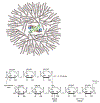Methodological considerations for studies of brain glycogen
- PMID: 30892752
- PMCID: PMC6565471
- DOI: 10.1002/jnr.24412
Methodological considerations for studies of brain glycogen
Abstract
Glycogen stores in the brain have been recognized for decades, but the underlying physiological function of this energy reserve remains elusive. This uncertainty stems in part from several technical challenges inherent in the study of brain glycogen metabolism. These include low glycogen content in the brain, non-homogeneous labeling of glycogen by radiotracers, rapid glycogenolysis during postmortem tissue handling, and effects of the stress response on brain glycogen turnover. Here we briefly review the aspects of the glycogen structure and metabolism that bear on these technical challenges and present ways they can be addressed.
Keywords: astrocytes; energy metabolism; glycogen.
Published 2019. This article is a U.S. Government work and is in the public domain in the USA.
Conflict of interest statement
Conflict of Interest Statement
The authors declare no conflicts of interest.
Figures



Similar articles
-
Technical and Comparative Aspects of Brain Glycogen Metabolism.Adv Neurobiol. 2019;23:169-185. doi: 10.1007/978-3-030-27480-1_6. Adv Neurobiol. 2019. PMID: 31667809 Review.
-
How glycogen sustains brain function: A plausible allosteric signaling pathway mediated by glucose phosphates.J Cereb Blood Flow Metab. 2019 Aug;39(8):1452-1459. doi: 10.1177/0271678X19856713. Epub 2019 Jun 17. J Cereb Blood Flow Metab. 2019. PMID: 31208240 Free PMC article. Review.
-
High glycogen levels in brains of rats with minimal environmental stimuli: implications for metabolic contributions of working astrocytes.J Cereb Blood Flow Metab. 2002 Dec;22(12):1476-89. doi: 10.1097/01.WCB.0000034362.37277.C0. J Cereb Blood Flow Metab. 2002. PMID: 12468892
-
Monoaminergic Control of Cellular Glucose Utilization by Glycogenolysis in Neocortex and Hippocampus.Neurochem Res. 2015 Dec;40(12):2493-504. doi: 10.1007/s11064-015-1656-4. Epub 2015 Jul 14. Neurochem Res. 2015. PMID: 26168779 Free PMC article. Review.
-
Glycogen metabolism and the homeostatic regulation of sleep.Metab Brain Dis. 2015 Feb;30(1):263-79. doi: 10.1007/s11011-014-9629-x. Epub 2014 Nov 16. Metab Brain Dis. 2015. PMID: 25399336 Free PMC article. Review.
Cited by
-
Time-dependent changes in hippocampal and striatal glycogen long after maze training in male rats.Neurobiol Learn Mem. 2021 Nov;185:107537. doi: 10.1016/j.nlm.2021.107537. Epub 2021 Oct 8. Neurobiol Learn Mem. 2021. PMID: 34634434 Free PMC article.
-
Decoding microglial immunometabolism: a new frontier in Alzheimer's disease research.Mol Neurodegener. 2025 Mar 27;20(1):37. doi: 10.1186/s13024-025-00825-0. Mol Neurodegener. 2025. PMID: 40149001 Free PMC article. Review.
-
Brain Glycogen-Its Metabolic Role in Neuronal Health and Neurological Disorders-An Extensive Narrative Review.Metabolites. 2025 Feb 13;15(2):128. doi: 10.3390/metabo15020128. Metabolites. 2025. PMID: 39997753 Free PMC article. Review.
-
The multifaceted roles of the brain glycogen.J Neurochem. 2024 May;168(5):728-743. doi: 10.1111/jnc.15926. Epub 2023 Aug 9. J Neurochem. 2024. PMID: 37554056 Free PMC article. Review.
-
Glycogen synthase GYS1 overactivation contributes to glycogen insolubility and malto-oligoglucan-associated neurodegenerative disease.EMBO J. 2025 Mar;44(5):1379-1413. doi: 10.1038/s44318-024-00339-3. Epub 2025 Jan 13. EMBO J. 2025. PMID: 39806098 Free PMC article.
References
-
- Baker DJ, Timmons JA, & Greenhaff PL (2005). Glycogen phosphorylase inhibition in type 2 diabetes therapy: a systematic evaluation of metabolic and functional effects in rat skeletal muscle. Diabetes, 54(8), 2453–2459. - PubMed
-
- Banay-Schwartz M, Kenessey A, DeGuzman T, Lajtha A, & Palkovits MJA (1992). Protein content of various regions of rat brain and adult and aging human brain 15(2), 51–54.
-
- Borke RC, & Nau ME (1984). Glycogen, its transient occurrence in neurons of the rat CNS during normal postnatal development. Brain Res, 318(2), 277–284. - PubMed
-
- Calder PC (1991). Glycogen structure and biogenesis. Int J Biochem, 23(12), 1335–1352. - PubMed

